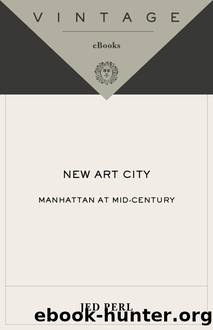New Art City by Jed Perl

Author:Jed Perl [Perl, Jed]
Language: eng
Format: epub
ISBN: 978-0-307-53888-8
Publisher: Knopf Doubleday Publishing Group
Published: 2005-11-15T00:00:00+00:00
IX
By the late 1950s, visits by artists and critics to Smithâs home and studio not far from Lake George had become fairly common. Frank OâHara described Smith as a large no-nonsense man with a mustache and a ââplainâ manner.â He âprepared delicious meals himself, offered excellent wines and cigars, and spoke of his love of Renaissance music (particularly Giovanni Gabrieli) and Mozart and the writings of James Joyce, of his interest in the musical ideas of John Cage, in the dancing and choreography of Merce Cunningham.â37 And even as Smithâs personality held visitors in thrall, they were wondering at the extraordinary outpouring of new work, which continued uninterrupted from the early 1950s until his death in 1965, when the truck he was driving ran off the road.
Like de Kooning, Smith had learned about the School of Paris from the great eccentric figure John Graham. And, like de Kooning, at least like the de Kooning who was spending more and more time on Long Island in the 1960s, Smith was an artist in whose imagination the pastoral and the urban had their places, side by side. Considering the uses to which Smith put scrap iron, it might be said that in his work the pastoral and the urban converged. The fields around Smithâs Bolton Landing home offered spectacular vistas of mountain, timber, and meadow. Hilton Kramer described the situation dialectically, as âa machine shop in a landscape,â and Smithâs Terminal Iron Works, relocated from Brooklyn to upstate New York, demonstrated the survival, as a matter of artistic choice, of the lost childhood of the Industrial Revolution.38 Visitors saw arrayed in the fields a vision that was at once old and new, artisanal and experimentalâranging from the expansive linear arabesques of such early 1950s pieces as the rapidly unfurling Australia and the somewhat slower-moving Hudson River to constructions of steel rectangles and cubes from the 1960s. There were rows of the Voltri-Boltons and Voltons, skeletal images, generally with a slim vertical human look, many of which seemed to act as frames or mounts for the beautiful, handmade tongs or pincers that Smith had brought back from the factories at Voltri. Next to these weird presences, which still had the afterglow of Surrealist-Baroque scribbles, were the Cubis, constructions of sleek steel boxes assembled into gravity-defying pileups, like childrenâs blocks gone mad. And then there were the Circles and Primo Pianos, broad flat forms cut out of sheets of steel and often painted white, a kind of three-dimensional rendering of flat-shape painting, with circles that were said to be inspired by Smithâs interest in the early canvases of Kenneth Noland, but that also suggested an affinity with the general upsurge in hard-edged Constructivist work in the late 1950s, of which Diller and Kelly were a part.
Download
This site does not store any files on its server. We only index and link to content provided by other sites. Please contact the content providers to delete copyright contents if any and email us, we'll remove relevant links or contents immediately.
Wonder by R.J. Palacio(8430)
Mastering Adobe Animate 2023 - Third Edition by Joseph Labrecque(3712)
Unlabel: Selling You Without Selling Out by Marc Ecko(3574)
Ogilvy on Advertising by David Ogilvy(3483)
Hidden Persuasion: 33 psychological influence techniques in advertising by Marc Andrews & Matthijs van Leeuwen & Rick van Baaren(3454)
Drawing Cutting Edge Anatomy by Christopher Hart(3437)
The Pixar Touch by David A. Price(3344)
POP by Steven Heller(3297)
The Code Book by Simon Singh(3055)
The Art of War Visualized by Jessica Hagy(2932)
Slugfest by Reed Tucker(2923)
The Curated Closet by Anuschka Rees(2897)
Rapid Viz: A New Method for the Rapid Visualization of Ideas by Kurt Hanks & Larry Belliston(2813)
Stacked Decks by The Rotenberg Collection(2796)
365 Days of Wonder by R.J. Palacio(2737)
The Wardrobe Wakeup by Lois Joy Johnson(2717)
Keep Going by Austin Kleon(2681)
Tattoo Art by Doralba Picerno(2582)
Tell Me More by Kelly Corrigan(2579)
